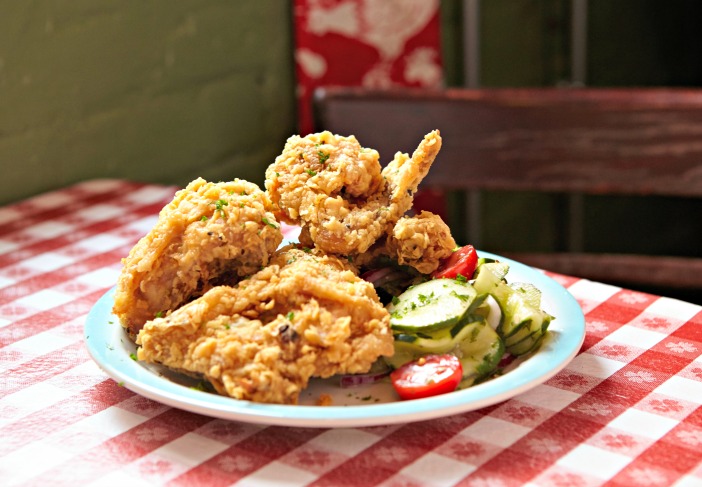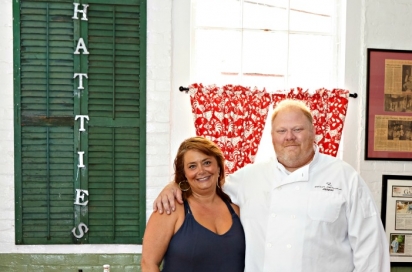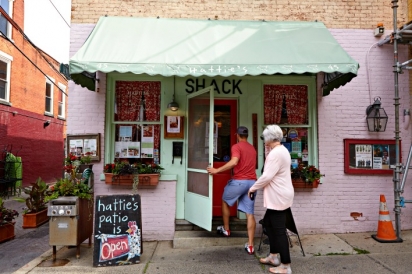Hattie's
You can’t buy love or authenticity, but in the highly curated, filtered and fluffed landscape the food world inhabits, chefs and restaurateurs are trying to sell it.
These days, establishments in the business of peddling food almost reflexively provide information about a product’s origins, its sustainability, its freedom from pesticides and GMOs (genetically modified organisms).
“Farm to table has become a hip marketing ploy,” Jasper Alexander, chef and owner of Hattie’s Restaurant and Hattie’s Chicken Shack in Saratoga Springs, says. “It’s been part of my food consciousness forever, but I have never put it on the menu, until recently. It was a complicated decision because while we have worked with Shelton Farms, who custom-grow an heirloom potato for us that we use in fries year round plus our produce in the summer, our steak comes from Snake River Farms and dairy products from Cabot, King Brothers, Meadowbrook and Battenkill Creamery, we’ve never advertised it on the menu. I did worry that now people would think we were just throwing it out there for show if we added it. In the end, though, I realized through fielding questions and getting feedback, customers expect to see sourcing information on their menus, and I wanted mine to acknowledge the farmers we work with.”
He has a point. In an astounding, highly researched and widely circulated series of articles (“Farm to Fable: At Tampa Bay Restaurants, You’re Being Fed Fiction”) in the Tampa Bay Times, food critic Laura Reiley traced claims on menus to their purported sources and found that the vast majority—90%—of her local restaurants are either stretching the truth or actually lying about the provenance of their food. On menus across the country, restaurateurs name-drop local farms, but the realities of scale and distribution (how much artisanal goat cheese can one small-time cheesemaker crank out?) are making it increasingly clear that some people are fibbing.
Jasper, for one, is the first to admit that not every fried chicken thigh he serves is from Misty Knolls or Murray’s. (He does use them as much as possible and all of the jerk chicken on the menu comes from them). “I would love to partner with a local chicken farmer who can grow enough big chickens to supply us, but at this point, I haven’t been able to work it out, primarily because business ebbs and flows for us so much, it would make the chicken farmer’s life very difficult.”
As a young chef, Jasper sharpened his knives working with the original farm-to-table purveyors of haute, ethical cuisine, New York City’s Gramercy Tavern and Gotham Bar & Grill. The food ethos he learned there informs every buying decision he makes now. Jasper’s commitment to community, fairness and sustainability may begin with how he stocks his larder, but it delves deeper.
“Hattie’s isn’t just a Saratoga Springs institution, it’s a national institution, and carrying the torch of the restaurant’s founder and honoring her legacy is part of how Beth and I decided to run the business early on,” Jasper says.
Beth, his partner in life and business, runs the front of the house.
Hattie’s was founded in 1938 by Hattie (Gray) Autin Moseley (1900–1998). Born in Louisiana, Moseley’s mother died in childbirth. As a young woman, Hattie held jobs as a domestic and restaurant worker. When she was widowed and living in Saratoga in 1938, she used every last scrap of her savings to launch a food stand. The Southern-style fried chicken, biscuits and soulful (and, yes, seasonal) sides soon gained a robust following. It was so successful, she kept it open 24 hours a day to cater to the high-rolling horse crowd and late-night, smoke-filled jazz scene that dominated the town in those days. Within a year, it was a full-time restaurant.
It was never really a business though. “Hattie would take in all kinds of people and put them to work when no one else would,” Jasper says. “She’d help runaways and drop-outs, nurture them, make them go to school, even bring them home to live with her. No one ever went hungry around Hattie’s, even if they couldn’t pay.”
Somehow, Hattie’s generous spirit was balanced by the rabid enthusiasm with which locals and visitors from afar embraced her Southern Louisiana–style cookery, and she never went belly up.
Beth and Jasper met working at Siro’s in the mid-1990s, and as Jasper says, “It was a summer fling that stuck.” They married in 1998 and have two children, Zoe, 16, and Charlie, 10, and both can frequently be seen at Hattie’s hanging and working with their parents. The Alexanders bought Hattie’s in 2001 (they’re the third owners) and have also managed to walk the exceedingly thin line between largesse and responsibility.
Hattie’s hosts a sprawling annual Mardi Gras party that benefits local institutions, including the Saratoga Performing Arts Center, the Saratoga Hospital Foundation and Jake’s Help From Heaven. So far, Hattie’s fetes have raised about $750,000 for local charities, Jasper says.
Then there’s also the offshoot Jasper and Beth run, called Hattie’s Chicken Shack in the Wilton Mall. Opened in 2010, it’s more casual, with counter service, but it’s still chef-driven and committed to hospitality and fried perfection. It’s also open for lunch.
Maybe you can’t buy love or authenticity. But you can buy into a business built on it. And at Hattie’s, along with the knowledge that you are supporting a legendary, open-hearted institution, you get crunchy, hot, juicy fried chicken, some of the best in the country, according to delirious reviews in Food & Wine Magazine, the New York Times and other arbiters of culinary excellence. As Jasper, Beth, Zoe and Charlie whiz around, working, greeting, comforting and seating their guests, the vibe is home, hearth, heart. Except with better food, and no cleanup required.
Hungry for more? Order Jasper’s first book, published in August 2016: The Hattie’s Restaurant Cookbook: Classic Southern and Louisiana Recipes (Countryman Press).







